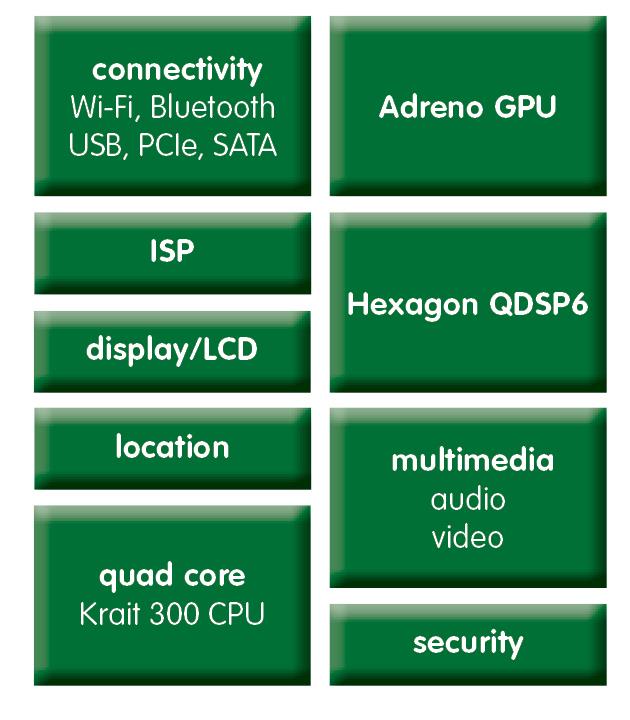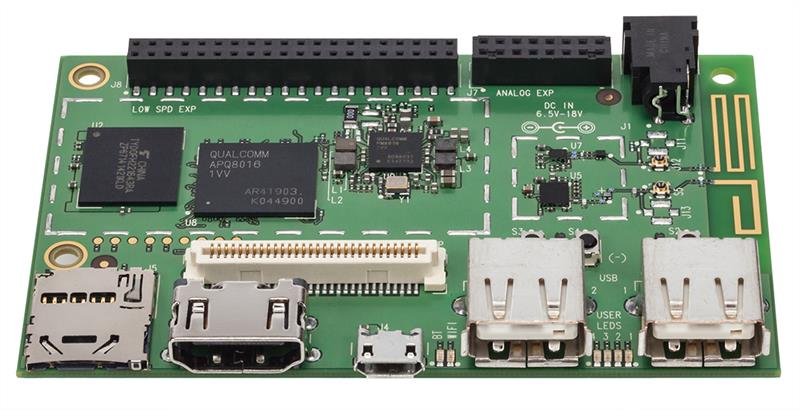Numbering base stations and mobile phone manufacturing amongst its earlier activities, the company narrowed its focus to the design of mobile phone processors. In particular, Qualcomm is known for the Snapdragon range of SoCs, some featuring CPUs designed by the company under the terms of an architectural license from ARM. But two recent announcements have signalled something of a change in the company’s outlook. One, the launch of the Centriq 2400, brings data centres within its target markets. The other was the announcement in September 2016 that its Snapdragon 410E and 600E processors would be available through distribution. The E in the product names is significant; both devices are aimed at the embedded systems market.
Leon Farasati, director of product management for Qualcomm’s embedded business, said: “Qualcomm is traditionally a mobile company, but we started to see demand for Snapdragon devices from the embedded world. What we realised was that our business model didn’t work for the embedded market.”
The issue was that the mobile market comprises a ‘handful’ of OEMs, according to Farasati, who buy chips in huge volumes. It’s the reverse for the embedded market. Farasati continued: “There are many potential customers who will buy in low volumes. It’s taken us a while to sort things out.”
The introduction of the Snapdragon 600E and 410E processors, along with global availability through distribution is said by Qualcomm to address the needs of ‘highly fragmented consumer, enterprise and industrial categories’. The Snapdragon embedded portfolio includes development boards, commercial ready modules and discrete processors for board level designs.
The two processors selected for embedded applications have both been available to the mobile market for a couple of years. “But their feature sets are right for the embedded market,” Farasati noted, “as is their performance and price.”
One of the changes which Qualcomm has had to make is to do with product availability. In the rapidly changing mobile communications world, long term availability isn’t an issue; but it is for embedded systems. “We have committed to making the 410E and 600E available for 10 years,” Farasati asserted. “And we also needed to make them available via distribution.” That latter point has been covered through an agreement with Arrow Electronics.
Last September, Raj Talluri, senior vice president, product management, with Qualcomm Technologies, said: “Snapdragon is a powerful and versatile processor with many potential applications in a variety of IoT applications. We can now offer this technology to a much wider range of customers with the additional benefit of long-term support and availability.”
According to David West, Arrow Electronics’ senior vice president: “Arrow looks forward to offering Qualcomm’s Snapdragon processors and complementing them with the full range of parts and engineering services we can offer to help customers through to commercialisation.”
The 410E and 600E are targeted at a wide range of applications, all under the general heading of IoT. But Qualcomm notes that potential markets include digital signage, medical imaging, point of sale systems and industrial robotics.
Justifying its move, Qualcomm noted ‘these embedded processors offer device manufacturers, solution providers and system integrators tremendous options for speeding commercialisation through a variety of off-the-shelf and custom modules, as well as the freedom for a chip on board design’.
 The Snapdragon 600E (see fig 1, left), built around Qualcomm’s 1.5GHz quad core Krait 300 CPU, is said to be suitable for building advanced systems. Immersive 3D graphics are available via the Adreno 320 GPU and Qualcomm’s Hexagon DSP. Connectivity is provided through integrated Bluetooth 4.0 Low Energy, Bluetooth 3.x, IEEE802.11a/b/g/n/ac and GPS. It also comes with SATA, SD3.0, DDR memory, eMMC storage, HDMI, LVDS, HSIC, and PCIe interfaces.
The Snapdragon 600E (see fig 1, left), built around Qualcomm’s 1.5GHz quad core Krait 300 CPU, is said to be suitable for building advanced systems. Immersive 3D graphics are available via the Adreno 320 GPU and Qualcomm’s Hexagon DSP. Connectivity is provided through integrated Bluetooth 4.0 Low Energy, Bluetooth 3.x, IEEE802.11a/b/g/n/ac and GPS. It also comes with SATA, SD3.0, DDR memory, eMMC storage, HDMI, LVDS, HSIC, and PCIe interfaces.
Meanwhile, the Snapdragon 410E boasts a quad core Cortex-A53 processor, blending high performance with low power consumption. Multimedia is supported by the Adreno 306 GPU and Hexagon DSP, while connectivity options include Bluetooth 4.1, Bluetooth Low Energy, IEEE802.11b/g/n and GPS. This, Qualcomm contends, suits the processor to smart home, medical equipment and industrial automation applications, amongst others.
Farasati added: “The Hexagon DSP is full time processor and one of the things we’ve been looking at is having a real time OS running on the DSP and maybe on Snapdragon itself.”
One other big change addressed by Qualcomm is the operating system. “It’s Android in the mobile market,” Farasati noted, “but it’s Linux in the embedded world. So Qualcomm has become a member of the Linaro organisation. And because we need a strong ecosystem, we have created a community.”
Another issue differentiating the mobile and embedded worlds is packaging. “We needed a different package,” Farasati admitted. “We had to change the package to something which could be guaranteed to have a 10 year lifetime.”
Where the 600E is supplied in a 23 x 23mm BGA, with 784 balls at a pitch of 0.8mm, the 410E comes in Qualcomm’s nanoscale package – or NSP – measuring 14 x 12mm, with 760 balls spaced at 0.4mm.
While Qualcomm has started with two parts, Farasati said there will be more added. “But, before we do bring out more E parts,” he noted, “we will need to have everything in place.”
There is also the continuing issue of availability. Although Arrow was named as the first distributor for Qualcomm’s embedded processors, it said that a global distribution network would be established.
Development support The DragonBoard 410c development board, manufactured on behalf of Arrow, is based on the 96Boards specification and is aimed squarely at the software, maker and embedded OEM communities.
DragonBoard 410c, pictured, features 1Gbyte of DDR3 RAM and 8Gbyte of flash, with a microSD expansion slot. Taking advantage of the 410E’s connectivity features, DragonBoard 410c also comes with 12 GPIO pins and SPI, I2C and UART ports. Shipping with Android 5.1 preloaded, the board also runs Linux Ubuntu and Windows 10. Intrinsyc’s Open-Q 410 system on module (SOM) is a 44 x 26.5mm production ready part. Its small form factor is said by the company to provide a suitable platform for creating low cost, high performance embedded devices. The Open-Q 410 is being used by US company Knit Health in an intelligent camera which monitors and tracks childrens’ sleep patterns. While product development started using the Dragonboard 410C, Knit moved to the Open-Q 410 SOM. “Getting a new SOM cheap enough to put in a consumer product is a very new thing,” said co-founder Paul Silberschatz. “For us, as a startup scaling in the 1000s to 10000s of units, it’s not breaking the bank. It’s a game changer compared to 10 years ago, when it would cost 10 times as much to get that level of processing in that form factor.” |














